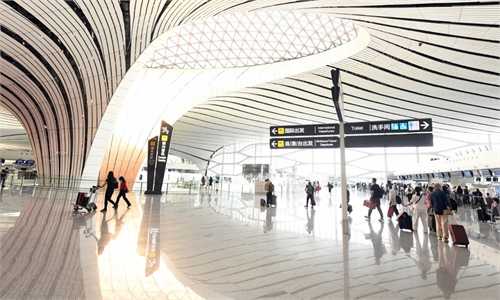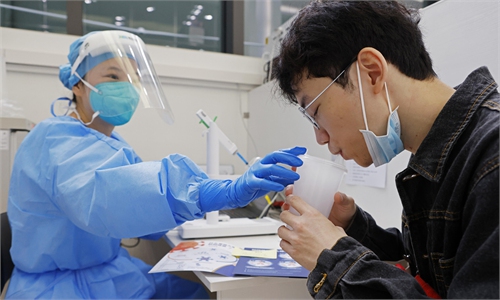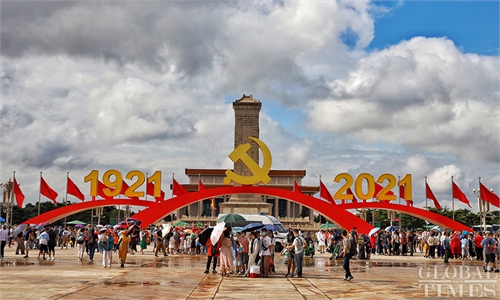Strict COVID prevention and control must be combined with optimized measures; ‘strenuous efforts on both’: Chinese authorities

Photo:VCG
The roll-out of 20 measures to optimize COVID-19 response is a decision based on scientific evidence and does not mean loosening prevention and control against the virus, still less a lift of COVID-19 restrictions or "lying flat" in the fight against the epidemic, Chinese government officials stressed on Saturday, noting that strict epidemic prevention and control must be comined with optimized measures, and that "strenuous efforts must be put on both."
At a press conference held by the State Council Joint Prevention and Control Mechanism against COVID-19 on Saturday, Mi Feng, a spokesperson from the China's National Health Commission (NHC) reiterated that the 20 measures are designed to optimize the country's nineth edition of diagnostic and treatment protocols for COVID-19, to make the implementation of the measures more science-based and precise. "They certainly do not mean we can slacken our response or even simply end COVID restrictions and lie flat."
Lei Haichao, deputy director of the NHC, said at the Saturday press conference that the roll-out of the 20 measures could significantly resolve obstacles and bottlenecks confronted in local epidemic work such as the tight quarantine resources and shortage of rooms for quarantine. Lei further noted that there is huge pressure on epidemiological study and relatively limited manpower to carry out this work
The Chinese government on Friday released a circular detailing the further optimization of its COVID-19 response, announcing 20 prevention and control measures. The new measures include cutting the centralized quarantine period for close contacts and international arrivals and that the categories of COVID-19 risk areas will be adjusted from three categories of "high", "medium", and "low" to two categories of just "high" and "low" to minimize the number of people subject to lockdown or health monitoring.
Chang Jile, vice director of the Chinese Center for Disease Control and Prevention, the Chinese equivalent of the CDC, said cutting the centralized quarantine period to five days at designated sites plus three days of home quarantine from previous seven-day quarantine plus three-day health monitoring at home could reduce the burden on the country's quarantine resources by 30 percent.
Chang also revealed that the longest incubation period for Omicron variant is determined to be eight days, which explains why the period is set at "five plus three."
The adjustment in shortening centralized quarantine period has been made based on data and evidence. It doesn't mean the necessity of centralized quarantine is decreasing. "In the future, we will not rule out further optimization of our quarantine measures," Wang Liping, a research fellow at the Center for Disease Control and Prevention , noted at the Saturday press conference.
Among the 20 optimized measures, close contacts of the clost contacts, or secondeary close contact, will no longer be screened. According to Chang, assessments found the positive rate among secondary close contacts is very low - about three in 100,000, and the figure could be reduced by identifying and taking quarantine measures for close contacts in a timely manner.
"Without identifying secondary close contacts can save a lot of resources for service assurance," he said, explaining the cancellation of identifying secondary close contacts.
Chang emphasized that the adjustements do not loosen China's response to the COVID-19, but instead make it more demanding. The optimized measures request our control and prevention works to be more scientific, more standardized and faster, and better coordinate between pandemic response and socioeconomic development.
To ensure the implementation of the optimized measures and curbing local government ramping up COVID response measures, including excessive policy steps, Lei stated on Saturday that task force dedicated to resolving issues related to local governments ratcheting up virus-containment measures or applying rigid steps have been set up across the country.
"We are scheduling every day to respond effectively to various problems reported by netizens and people in various places," he said.
Officials at the press conference also vowed to remain committed to a people-first, life-first ideal that Chinese government has long held in its anti-virus fight.
There were heartbreaking incidents at various places where people with basic medical service needs could not access treatment in a timely way, Lei said.
The NHC deputy head urged that once an outbreak occurs, local authorities must be prepared to provide basic healthcare services and have adequate vehicle and personnel for emergency use. "They must not refuse to take in patients as a way to reduce the risk of epidemic control and prevention to zero," he stressed.
When responding media inquires on whether the measures mean the overall COVID-19 response would end in the near future, Lei said that China will continue to optimize and adjust relevant measures according to the characteristics of the variants and knowledge with China's clinic treatment practice, and base the decisions on the improvement and enhancement of the country's ability in prevention and control to balance the epidemic fight with the country's socioeconomic development.
Local governments across the country have made swift adjustments for COVID-19 prevention and control measures after the 20 measures was released on Friday, local media reported.
Guangzhou municipal authorities said on Friday afternoon that they would make adjustments for quarantine periods for close contacts and international arrivals, stop identifying secondary close contacts and lift quarantine measures for those who are currently in quarantine.
Beijing municipal government officials on Saturday announced the launch of a special relief mechanism, effective from Saturday, for people who have been stranded outside Beijing for extended periods, vowing to help address situations for people who had visited high risk areas outside Beijing.
The Beijing government will also take the initiative to contact those who have been stuck outside Beijing for more than a month and still want to return to Beijing, to help lift restrictions on their Beijing Health Kit pop-up windows and ticket purchases in a timely fashion.




